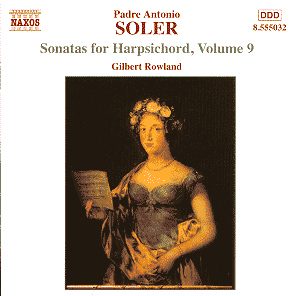Naxos have now progressed to volume nine of Soler’s
sonatas for harpsichord in what has been a generally well received
survey. Presented on this release is a generous selection of eleven
works which include the substantial four movement sonata No.99.
Catalonian composer Padre Antonio Soler took
holy orders to become a monk at the Escorial monastery, near Madrid
and became a pupil of master keyboard composer Domenico Scarlatti.
Soler may not be as highly regarded as his teacher in many circles,
however much of the skill and creativity has undoubtedly rubbed-off.
Like his teacher Scarlatti many of these sonatas are characterised
for their Spanish flavour of Flamenco song, energetic dance and
guitar-like strumming.
Soler wrote much sacred music but he is chiefly
remembered for his over 150 keyboard sonatas the majority of which
were composed for the harpsichord. Soler’s sonatas, as seen on
this release, are generally presented in a single movement although
a few of them can be found in several movements. We are told in
the excellent booklet notes by harpsichord soloist Gilbert Rowland
that researchers now consider it was customary to perform many
of the short single movement sonatas in pairs.
Arguably Soler’s sonatas for harpsichord are
more conventional and have slightly less character than those
of Scarlatti but on this release soloist Gilbert Rowland proficiently
displays countless episodes of flair imagination and many surprises.
Gilbert Rowland gives a fine performance making
light work of both the fiendishly difficult and flamboyant sonatas
13 and 14 and the technical demands of the sonata 119 with its
organ-like qualities. The machine-like drive and vigour necessary
in sonata 72 and the repetitive and rapid main theme of the sonata
No. 12, which sounds like a cross between the nursery rhythm ‘Three
Blind Mice’ and Mendelssohn’s ‘Wedding March‘, present little
difficulty for the soloist owing to his superb dexterity and control.
Rowland can play with sensitivity and refinement as heard in the
tenderly melodic and imaginative sonata 24, displaying character
and unequivocal communication in the Scarlatti-like theme in the
inventive sonata 25.
The modern two manual instrument built in 1998
by Wooderson, after Goermans of Paris (1750) did sound slightly
sharp initially until my hearing tuned into the textures. However
the harpsichord has a more than acceptable sound with an agreeable
tone and well-tuned but would have benefited from a slightly warmer
acoustic than that provided in the Epsom College Concert Hall.
Thankfully there are no intrusive sounds from the modern instruments
mechanism; unlike on many recordings that I have recently encountered.
I am familiar with an alternative digital versions
of the complete output of Soler from Bob van Asperen on the Astrée
label. Although the set is a fine achievement both for van Asperen
and Astrée I have reservations over the sound quality and
the documentation is poor, therefore this Naxos version is my
first choice.
Many discs of harpsichord works do not always
make for sustained listening but with this Naxos release the enjoyment
was certainly enduring. A really fine performance from Gilbert
Rowland who was an inspired choice by Naxos for this cycle of
Soler sonatas.
Michael Cookson
